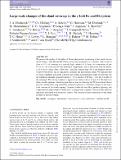Large-scale changes of the cloud coverage in the ɛ Indi Ba,Bb system
Abstract
We present the results of 14 nights of I-band photometric monitoring ofthe nearby brown dwarf binary, ɛ Indi Ba,Bb. Observations were acquired over 2 months, and total close to 42 hours of coverage at a typically high cadence of 1.4 minutes. At a separation of just 0.7″, we do not resolve the individual components, and so effectively treat the binary as if it were a single object. However, ɛ Indi Ba (spectral type T1) is the brightest known T-type brown dwarf, and is expected to dominate the photometric signal. We typically find no strong variability associated with the target during each individual night of observing, but see significant changes in mean brightness - by as much as 0.10 magnitudes - over the 2 months of the campaign. This strong variation is apparent on a timescale of at least 2 days. We detect no clear periodic signature, which suggests we may be observing the T1 brown dwarf almost pole-on, and the days-long variability in mean brightness is caused by changes in the large-scale structure of the cloud coverage. Dynamic clouds will very likely produce lightning, and complementary high cadence V-band and Hα images were acquired to search for the emission signatures associated with stochastic 'strikes'. We report no positive detections for the target in either of these passbands.
Citation
Hitchcock , J A , Helling , C , Scholz , A , Hodosan , G , Dominik , M , Hundertmark , M , Jørgensen , U G , Longa-Peña , P , Sajadian , S , Skottfelt , J , Snodgrass , C , Bozza , V , Burgdorf , M J , Campbell-White , J , Figuera Jaimes , R , Fujii , Y I , Haikala , L K , Henning , T , Hinse , T C , Lowry , S , Mancini , L , Rahvar , S , Rabus , M , Southworth , J & von Essen , C 2020 , ' Large-scale changes of the cloud coverage in the ɛ Indi Ba,Bb system ' , Monthly Notices of the Royal Astronomical Society , vol. 495 , no. 4 , pp. 3881-3999 . https://doi.org/10.1093/mnras/staa1344
Publication
Monthly Notices of the Royal Astronomical Society
Status
Peer reviewed
ISSN
1365-2966Type
Journal article
Description
Funding: LM acknowledges support from the University of Rome Tor Vergata through ‘Mission: Sustainability 2017’ fund. ChH and GH gratefully acknowledge the support of the European Research Council (ERC) Starting Grant no. 257431.Collections
Items in the St Andrews Research Repository are protected by copyright, with all rights reserved, unless otherwise indicated.

